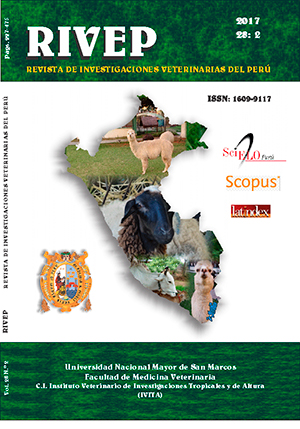Initial exploration of the genetic structure of domestic pig (Sus scrofa domestica) in Sampués, Sucre, Colombia, using microsatellites
DOI:
https://doi.org/10.15381/rivep.v28i2.13069Keywords:
microsatellite markers, Sus scrofa domestica, diversity, Hardy-Weinberg equilibrium, SampuesAbstract
The aim of this research was to evaluate the genetic variability of a population of domestic pigs (Sus scrofa domestica) in Sampués, Sucre, Colombia to determine their genetic status. Fifty samples were studied. Twenty microsatellites were used where five of them were from the list of those recommended by FAO/ISAG for studies of swine biodiversity and the remaining represent most of the pig genome. The microsatellites used were polymorphic, detecting between 3 (SW2019) to 14 (SW957) alleles with an average 6 and a total of 120. The mean expected heterozygosity was 0.5465 and the mean observed heterozygosity was 0.5203. The polymorphism information content (PIC) ranged between 0.2823 and 0.7252 for SW1041 and SW957 loci respectively. The results showed that the studied population as a group with a high degree of genetic diversity.Downloads
Downloads
Published
Issue
Section
License
Copyright (c) 2017 Enrique Pardo P., Alfonso Calderón R., Guillermo Arrazola P.

This work is licensed under a Creative Commons Attribution-NonCommercial-ShareAlike 4.0 International License.
AUTHORS RETAIN THEIR RIGHTS:
a. Authors retain their trade mark rights and patent, and also on any process or procedure described in the article.
b. Authors retain their right to share, copy, distribute, perform and publicly communicate their article (eg, to place their article in an institutional repository or publish it in a book), with an acknowledgment of its initial publication in the Revista de Investigaciones Veterinarias del Perú (RIVEP).
c. Authors retain theirs right to make a subsequent publication of their work, to use the article or any part thereof (eg a compilation of his papers, lecture notes, thesis, or a book), always indicating the source of publication (the originator of the work, journal, volume, number and date).










